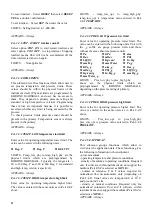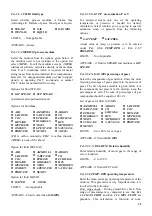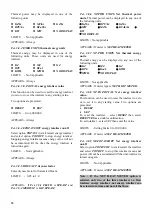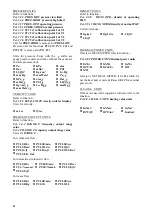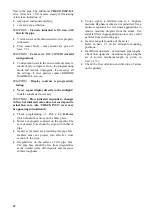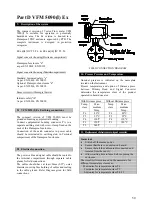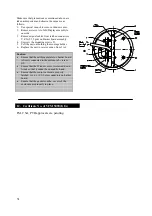
Fct. 4.3 PRES.OPR
operating pressure
Enter the mean (average) operating pressure of the
medium. This parameter is very important since it is
involved in following -
Flow range check - During plausibility check, flow
range of measurement is computed to see that
Fct.
1.1.2 MAX. FLOW
and
Fct. 1.1.3 MIN. FLOW
are plausible. This calculation is function of nom.
diameter, k-factor, fluid, medium and density.
Where density depends on operating pressure for all
mediums except
-NONE-
Flow computations - When pressure sensor is not
present, value given here is used in flow
computations for mass or normalized flow for all
mediums except
-NONE-
Pressure value can be entered in one of the units
same as in
Fct. 3.3.3.
LIMITS - Limits are same as those given in the
Fct.3.5.7.
APPEARS - if operating pressure is outside its
limits. This may happen if operating pressure range
is changed without changing the operating pressure
such that the operating pressure is outside its valid
limits.
Fct. 4.4 % GAS MIX
Percentage of gases
Select the components of gas mixture. Enter the
mole fraction percentage of gases present in the
mixture of gases. The list of gases available is given
below. For the components not present in the
mixture, keep the percentage as zero. The sum of
percentages of gas components should be equal to
100
±
0.1
List of gases for fluid GAS MIX -
l
AMMONIA
l
ARGON
l
I-BUTANE
l
N-BUTANE
l
CO
l
CO2
l
ETHANE
l
ETHYLENE
l
HEXANE
l
HYDROGEN
l
H2S
l
METHANE
l
NEON
l
NITROGEN
l
OXYGEN
l
I-PENTANE
l
N-PENTANE
l
PROPANE
l
XENON
LIMITS - 0 to 100 % for each gas
APPEARS - if fluid is
GAS MIX.
Fct. 4.5 MAX. FLOW
maximum flow rate
Enter the maximum flow rate desired. Max. flow
should be within measuring range for the given
primary data (3.1.x functions) and application data
(3.5.x functions). The frequency output range value
directly corresponds to max. flow. If flow rate
exceeds max. flow an error condition (
HIGH
FLOW
) is generated which may affect current
output depending on programming of
Fct. 1.3.2
RANGE I.
The following units are available to
choose from depending on programming of
Fct.
1.1.1 MEAS. INST.
For volumetric flow -
l
m3/hr
l
m3/min
l
m3/sec
l
Litre/hr
l
Lirtre/min
l
Litre/sec
l
ft3/hr
l
ft3/min
l
ft3/sec
l
cft/hr
l
cft/min
l
cft/sec
l
cuft/hr
l
cuft/min
l
cuft/sec
l
US Gal/hr
l
US Gal/min
l
US Gal/sec
l
UK Gal/hr
l
UK Gal/min
l
UK Gal/sec
For normalized volumetric flow -
l
Norm.m3/hr
l
Norm.m3/min
l
Norm.m3/sec
l
Norm.L./hr
l
Norm.L./min
l
Norm.L./sec
l
Sft3/hr
l
Sft3/min
l
Sft3/sec.
l
Scft/hr
l
Scft/min
l
Scft/sec
or mass flow –
l
Kg/hr
l
Kg/min
l
Kg/sec
l
T/hr
l
T/min
l
T/sec
l
Lb/hr
l
Lb/min
l
Lb/sec
LIMITS - Limit is calculated from the sizing
calculation from the application data and primary
data. Sizing involves :
-
Calculation of density at operating conditions.
(User supplied value is used for
unsupported medium -
NONE).
-
calculation of minimum velocity, Vmin, from
the graph of velocity vs. density. See diag. III in
section Technical data.
-
Maximum flow velocity,
Vmax = 135.7306 /
Ö
r
op
for sizes DN25 to 200( 1” to 8”)
= 83.87146 /
Ö
r
op
for sizes DN10S to 20( 3/8”S to 3/4”)
In both cases Vmax is clamped at 75m/s. For
densities at and above 50kg/m3, Vmin is fixed at
0.94192 m/s for all sizes
.
-
Volumetric flow limits are qv_min = Vmin*area
& qv_max = Vmax*area.
-
Normalized volumetric flow rate limits are
qvn_min = qv_min *opr_density/norm_density
and
qvn_max = qv_max*opr_density/norm_density.
-
Mass flow rate limits are
qm_min = qv_min*opr density and
qm_max = qv_max*opr_density.
38








